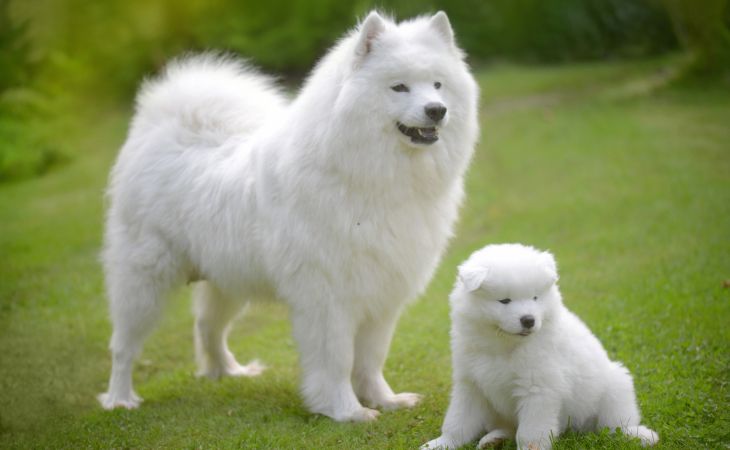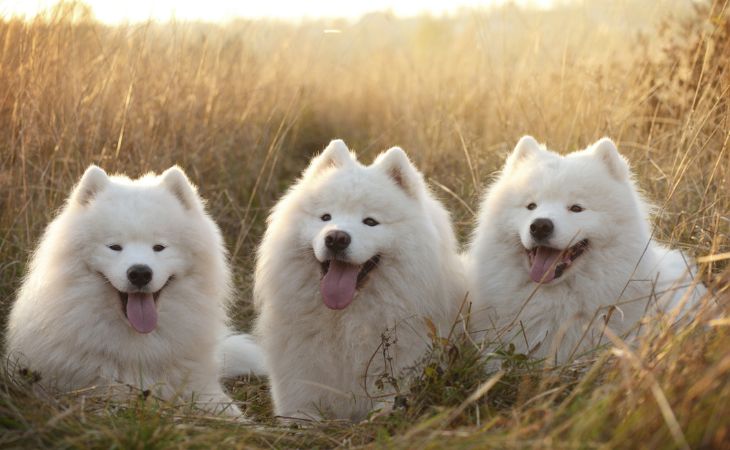Breed standard: FCI I Size: Medium I Average lifespan: 12+ years I Character: Playful, gentle, friendly I Coat length: Long I Origin: Siberia.
The Samoyed looks like a large teddy bear crossed with a wolf. Because Samoyeds are remarkably friendly and playful, many people are charmed by this breed.
The origins of the Samoyed
A dog breed from the Far North
This dog breed owes its name to the Samoyed tribe, who lives in the north of Siberia. The tribe is also known as the Nenets tribe. These people live by hunting and raising reindeer. They travel often across the tundra and the forests to find food to sustain themselves. Their dogs, Samoyeds, accompany them everywhere they go. Every family can have at least five of these dogs who play a tremendously important role in their household.
As these dogs are reindeer herders, hunters, and draught animals, the Samoyed people consider this breed to have the same value as people. For this reason, the Samoyed people feed these dogs with their leftovers. In addition, these dogs are excellent playmates for the children and are always welcome to sleep and search for warmth in their traditional tents when the temperatures reach -22°F.
Did you know that there is a tradition that when a child gets lost in the wild, they need to hold on to the neck of a Samoyed? When they do this, the Samoyed will guide them back to safety.
A breed that has adapted to its environment
This dog breed is believed to have originated from a mix of various dog breeds in the Far North. The Nenets people wanted to create a robust breed that could handle the freezing temperatures, help hunt, and keep an eye on the reindeer in the wide open spaces. By living with humans for so long, this dog breed has become an excellent guardian not only for children, but also for the entire village. When Samoyeds sense danger, they bark.
The breed came to Europe in 1889. This is because the zoologist E. Kilburn Scott took a Samoyed puppy named Sabaka with him to England. Shortly after, he brought two more Samoyeds with him, a male and female. These dogs are considered to be the basis of the breed nowadays. Several Samoyed breeders started to appear, and 20 years later, the first Samoyed breed standards were published. They were primarily used by polar explorers because of their resistance to physical effort and the cold.
Originally, Samoyeds had brown, cream, black , or gray coats. The white Samoyed appeared much later.
The character of the Samoyed
Despite their wild and impressive appearance, the Samoyed is the ideal companion. These dogs truly appreciate spending time with their owners. In addition, they are particularly fond of cuddles, exercise, and outdoor activities.

What are some of the Samoyed’s qualities?
As this breed has been accustomed to living with humans for generations, Samoyeds live in perfect harmony with their owners. Furthermore, this dog appreciates living with families with children. The Samoyed is a very gentle and friendly dog. This breed is not aggressive at all. Moreover, Samoyeds love greeting strangers while on walks. Because these dogs are so friendly and love cuddles, it’s not hard to imagine that these dogs are competing to see who can get pet the most!
In addition, these dogs enjoy playing and are unparalleled when it comes to being companions for young children.
While the Samoyed’s character is quite rustic, this breed can adapt very well to city life. As long as they have access to an outdoor space like a garden and can going on long walks regularly, this breed can live happily in the city.
It should be noted that this breed is particularly autonomous. They enjoy doing things alone.
With that being said, they get along very well with other dogs and can even share a home with another pet. They will particularly appreciate having another pet around if their owner needs to leave them alone for a while. When Samoyeds are left alone, they can get bored.
This breed is very gentle and attentive. They love cuddles and playing sessions with their family.
Are there any downsides to having a Samoyed?
While this dog breed is absolutely adorable, there are still a few downsides to having this breed. Known for being dogs who like to express themselves, this dog breed tends to bark often. Whether they are watching over the home or playing, you will surely hear the Samoyed’s deep voice.
To prevent these dogs from making too much noise, it’s important to teach them when they are still young that barking is not the best way to make themselves understood.
Training this breed can take time because the Samoyed is rather stubborn and obstinate. When these dogs do not want to do something, it is very difficult to change their mind. For this reason, it’s important to train this breed gently from a young age.
We already mentioned that the Samoyed needs to have an outdoor space to spend time in. That is because this dog absolutely loves the outdoors. This dog enjoys activities such as jogging in the nature with their owner. In addition, as this breed is very athletic, they are perfect for people who enjoy outdoor activities. For example, Samoyeds can do agility for fun or participate in dog sledding activities. Their need for physical activity must be taken into account when deciding whether or not the Samoyed is the right breed for you. If these dogs do not exercise enough, they could ruin your belongings or destroy your garden.
Training with a clicker is one of the best ways to teach your dog what they should and should not do.
Even though this breed is imposing, the Samoyed is not a very good guard dog. They would rather give hugs and affection. They are not distrustful at all.
The physical characteristics of the Samoyed
The different types of Samoyeds
Nowadays, the Samoyed tends to be homogenized. However, in the past, three distinct types of Samoyeds existed.
There were Samoyeds that were smaller than the standard Samoyed, similar to a fox. For this reason, they are given the name “fox“.
Conversely, there is the “bear” type of Samoyed, which is more stocky than the standard Samoyed. The face of this type of Samoyed is similar to the standard as they have small ears and lips that point upwards as if they were smiling. This type of Samoyed was very popular in the United Kingdom.
Lastly, the “wolf” type of Samoyed is more slim than the standard one. They have a strong musculature and bone structure. Additionally, their ears are bigger. This type of Samoyed is widely appreciated in the United States.
These differing physical features allow us to determine the lineage of the dog, but are not specific criteria for the standard.
General
Head
The skull is slightly convex and a little larger between the ears. The stop is very pronounced. This dog breed’s muzzle is imposing and held high. Their nose is black.
The ears are small, held straight, and triangular with the tops slightly rounded.
When it comes to the eyes, they are spread apart and almond-shaped. The eyes are a dark color.
Body
When you first look at a Samoyed, the first thing you notice is its stocky body. The body of this breed is longer than it is high with very pronounced withers. When it comes to the back, it is straight with short loins. The Samoyed has a impressive amount of muscles even though it’s hard to see the muscles with their dense fur. The rump is slightly inclined while the chest is large.
This breed’s tail is held high and curves toward the front.
Coat, color, and grooming
Coat
The coat is long and thick. When it comes to the undercoat, it is softer but also thick.
Around the head, the shoulders, and the neck, this dog has neck hair. This hair is more imposing on males.
The Samoyed has a hypoallergenic coat.
Colors
Nowadays, the majority of Samoyeds have a light-colored coat. The breed standard favors coats that are pure white. However, it is possible to see this dog breed with a cream coat. Beige, on the other hand, is not accepted.
Grooming the Samoyed
The molting period of the Samoyed differs depending on whether the dog is male or female. Male dogs only molt once a year while females molt two times a year. During these periods, Samoyeds molt a lot. It’s best to brush your dog several times a day to prevent your house from becoming covered in dog hair. You can also give your Samoyed a bath at the beginning of the molting period to help get rid of hair more efficiently.
It’s best to brush your Samoyed once a week outside of molting period. A brush with rigid bristles is more efficient to brush their thick hair. If your dog is dirty, you can also give them a bath. If you can, it’s best to use a dog shampoo that is specifically made for white hair.
You should also keep an eye on your dog’s teeth. Do not hesitate to brush your dog’s teeth regularly to get rid of plaque and tartar. It’s best to get your dog used to this at a young age.
Did you know?
Do you have a feeling that you’ve seen this white and fluffy dog breed somewhere? If you are a cinephile, it’s not surprising! A Samoyed is featured in the film The Proposal. The dog is named Kevin in the film and he looks absolutely adorable in Sandra Bullock’s arms!
Samoyeds are also featured in the film The Call of the Wild.
The Samoyed at a glance
Size: Male Samoyeds measure around 53 to 57 cm (≈ 1.7 to 1.9 ft). Female Samoyeds measure around 48 to 53 cm (≈ 1.6 to 1.7 ft).
Weight: There is also a difference in weight when comparing male and female Samoyeds. Males weigh around 20 to 30 kg (≈ 44 to 66 lb) while females with around 15 to 22 kg (≈ 33 to 48 lb).
Health: The Samoyed does not handle the heat very well. During the summer, it’s important to make sure that your Samoyed stays where it is fresh and not to hot. In general, this dog breed is healthy. With that being said, this dog breed can have problems with hip dysplasia.
Average lifespan: around 12 years.
Are Samoyeds good with children? The Samoyed is the ideal companion for children. They love to play and spend time with children.
How easy are Samoyeds to live with? This breed needs to be trained from a very young age. Otherwise, they will do whatever pleases them. If you are not a very active person, this dog breed is probably not for you. The Samoyed needs to move a lot and exercise. If you dedicate time to walking this dog breed and showing them affection, the Samoyed is easy to live with.

